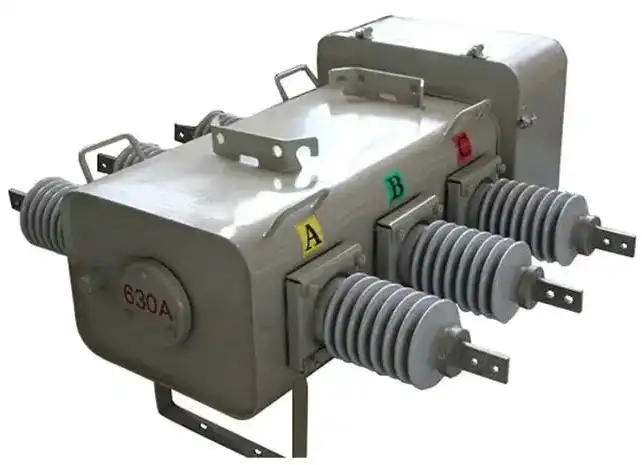Recloser vs. Load Breaker Switch

There are many devices designed to protect circuits and equipment in electrical distribution networks. Reclosers and load breaker switches (LBS) are two such devices that play critical roles in electrical network security. While they both provide comparable functions, there are significant distinctions between them.
Reclosers: Using Intelligence to Protect Electrical Networks
A recloser is a smart, self-contained device used in electrical distribution networks to identify and interrupt power line problems. Its major role is to improve power dependability by restoring power after transitory problems such as short circuits or line interruptions. The recloser does this by instantly isolating the defective segment of the power line and automatically re-energizing the line after a predefined time delay.
Reclosers have the following important characteristics:
Detection of Faults
Reclosers are outfitted with sensors and protective relays that monitor the electrical properties of the power line to identify defects such as short circuits or overcurrents.
Automatic Control
When a defect is discovered, the recloser cuts off electricity to the afflicted part. It automatically attempts to restore power flow after a specified time delay, generally a few seconds. This operation is continued until the recloser locks out, indicating a persistent defect.
Isolation of Faults
The recloser isolates the problematic portion by cutting the power supply, preventing the fault from impacting the remainder of the network. This reduces interruptions and enhances overall system dependability.
Monitoring and communication
Reclosers include connectivity capabilities that allow for remote monitoring and control. This enables utilities to collect data on fault incidents, analyze distribution system performance, and optimize maintenance actions.
Using a Load Breaker Switch to Ensure Safe Disconnection
A load breaker switch, often known as an LBS or simply a load switch, is a device that may be controlled manually or remotely to safely disconnect electrical equipment from the power supply. Load breaker switches, unlike reclosers, do not have automated fault detection and restoration capabilities. Instead, its primary function is to isolate and de-energize certain areas of an electrical network for maintenance or repair work.
Load breaker switches have the following characteristics:
Manual or remote control operation
Load breaker switches can be actuated manually (by a handle or lever) or remotely (via a control signal). This adaptability enables for simple disconnecting and reconnecting of loads without disrupting the overall power supply.

Isolation of Load
LBS units are typically used to separate electrical equipment from the power supply, such as transformers or capacitor banks. The flow of electricity to the equipment is blocked by opening the switch, assuring the safety of anyone working on or near the equipment.
Fault Protection Is Limited
While load breaker switches provide basic protection against overcurrents and short circuits, they are not designed to detect and restore faults. Instead, they concentrate on safe load separation and disconnection during maintenance or repair activities.
Now that we’ve established the essential distinctions between reclosers and load breaker switches, let’s look at some suggestions for when to utilize each:
Reclosers
Reclosers are best suited for situations where power dependability is critical. They are widely used in overhead distribution systems, where there are numerous brief faults caused by vegetation, lightning, or transitory line interruptions. Reclosers try to restore power automatically, reducing the duration of disruptions and enhancing overall service dependability. They are especially beneficial in regions with restricted access since their autonomous functioning eliminates the need for physical intervention.
Switches for Load Breakers
Load breaker switches are appropriate for scenarios requiring the selective disconnect and separation of electrical equipment. They are often used in substations, industrial facilities, and distribution networks to securely disconnect transformers, capacitor banks, and other loads for maintenance or repair. LBS units make it simple to isolate select areas of a network without disrupting the rest of the network.
Which variables should be considered before making a decision?
System Reliability Prerequisites
Reclosers are the recommended solution if the aim is to minimize power disruptions and restore service automatically. Load breaker switches, on the other hand, should be used if the major goal is selective load separation for maintenance purposes.
Characteristics of Faults
Reclosers are designed to detect and restore power after brief outages. A recloser would be useful if the network had periodic transient problems, such as those induced by brief disruptions. However, if the failure persists or requires more investigation, an LBS may be used to isolate the faulty equipment for complete analysis and repair.
Considerations for Maintenance and Safety
Load breaker switches ensure greater safety during maintenance procedures. They guarantee the safety of persons operating on or near the equipment by separating certain loads. Reclosers, although providing automatic fault restoration, may need manual intervention during maintenance or repairs.
Cost and complexity of the system
Reclosers offer more extensive functionality and communication capabilities, making them appropriate for complicated distribution networks. However, their greater complexity frequently comes at a larger cost. Because they are simpler devices, load breaker switches are more cost-effective for basic load separation requirements.
Finally
In electrical distribution networks, reclosers and load breaker switches fulfill various functions. Reclosers are clever devices that detect and restore power after brief outages, improving system dependability. Load breaker switches provide the safe isolation of certain loads for maintenance or repair operations. Understanding their peculiarities and taking into account the individual needs of the electrical network will aid in determining the best device to employ in each circumstance, assuring optimal system performance and safety.



